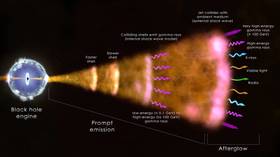From the brightest lights, to the eeriest sounds, and finally...LIFE on Mars? What we learned about space this week

Scientists around the world are constantly striving to learn more about our universe. Discoveries from the utterly minute to the absolutely massive are made every day and this past week has seen some truly breathtaking highlights.
Here, RT details what we learned about space in the past week.
Sugar is the origin of life?
NASA, in collaboration with three Japanese universities, discovered extraterrestrial sugar molecules on two different meteorites which struck the Earth, leading some scientists to believe that the RNA component within the sugar may have been the early catalyst for life on our planet.
Also on rt.com NASA discovers alien SUGAR on board two fallen meteorites indicating possible origin of LIFE on EarthBrightest light ever seen by mankind
Despite discovering them almost 50 years ago, scientists had to wait until this year to directly witness a gamma ray burst, a truly gargantuan event that emits more energy in seconds than our own sun would in 10 billion years.
Also on rt.com Astronomers capture brightest light ever seen by humanity, more energy in seconds than 10bn years of our sunHaunting sound of a solar storm
Not content with extraordinarily bright lights, scientists used four earth-orbiting satellites to listen to the sound of a solar storm smashing into our planet’s magnetosphere with somewhat terrifying and disturbing results.
Also on rt.com LISTEN: The sound of Earth being lashed by solar storm will haunt your nightmaresMusk the polluter
All was not well in low-Earth orbit, however, as the astronomical community was up in arms over Elon Musk and Space X’s Starlink project polluting the skies with unnecessary light while attempting to provide satellite internet to those back on terra firma.
Wow!! I am in shock!! The huge amount of Starlink satellites crossed our skies tonight at @cerrotololo. Our DECam exposure was heavily affected by 19 of them! The train of Starlink satellites lasted for over 5 minutes!! Rather depressing… This is not cool! pic.twitter.com/gK0ekbpLJe
— Clarae Martínez-Vázquez (@89Marvaz) November 18, 2019
With some 120 miniature satellites currently in orbit, and mass complaints already rolling in, it remains to be seen whether the light-polluting Musk will realize his goal of sending an additional 30,000 micro satellites into orbit in the future.
Also on rt.com 'Man who polluted heavens': Astronomers furious over Musk's Starlink satellites clouding their vision(Insect) life on Mars?
The outrage among the scientific community extended further into the solar system this week, after Ohio University Entomologist William Romoser claimed to have evidence of insect-like creatures living on the surface of Mars. So strong was the backlash to Romoser’s claims, in fact, that the he caved and requested that the initial press release be taken down (though copies still exist online).
Biology professor at Oregon State University David Maddison claimed it was yet another case of pareidolia (where humans see faces and other shapes in inanimate objects).
“The faculty member no longer wishes to engage with media regarding this research, so we have opted to remove the story from our website and EurekAlert,” Ohio University spokesperson Jim Sabin said in statement.
A fifth force of nature
Also on rt.com Physicists claim to have found NEW force of nature which may unravel one of the universe’s greatest MYSTERIESAnd finally, in a breakthrough that could solve one of the great mysteries of the universe, scientists at the Institute for Nuclear Research in Hungary published their latest findings after years of researching both beryllium and helium.
They now believe they have discovered a new boson, which they have named X17, and which may prove to be the missing link which will finally unravel the riddle of dark matter.
Like this story? Share it with a friend!












